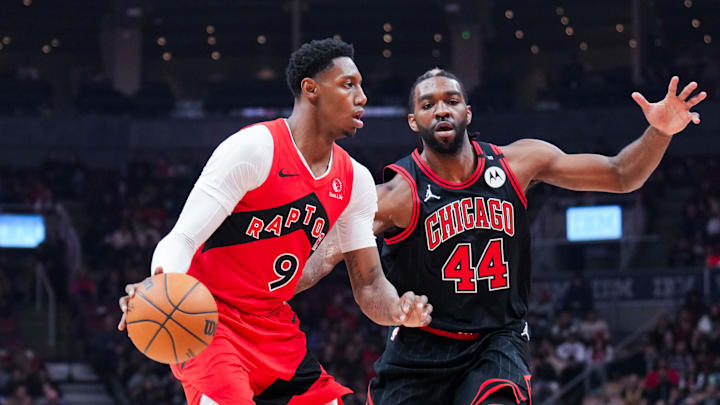The NBA Draft is less than a week away. Pre-draft questions and critiques are beginning to amplify, and trade rumors are heating up. Two notable trades have already been executed. First, the Memphis Grizzlies sent Desmond Bane to the Orlando Magic in a blockbuster swap that included Orlando's 2025 first-rounder alongside three additional unprotected firsts.
Furthermore, the still competing Indiana Pacers sent the 23rd pick in the first round to the New Orleans Pelicans in exchange for their 2026 first-rounder. However, the run of trades won't stop there. Expect more trades to go down over the next few days and a plethora on both draft nights.
In anticipation of one of the busiest transaction days of the year, ESPN formulated five trades that would shake up the first round. The Worldwide Leader in Sports composed five trades, including 10 teams, with the Chicago Bulls being one of them.
Bulls ditch 12th pick for salary cap relief and RJ Barrett
In the mock trade, ESPN has Chicago sending Patrick Williams, Jevon Carter, and the 12th overall selection to the Toronto Raptors for RJ Barrett.
ESPN's Chris Herring provided insight on why the trade makes sense for both sides. For the Bulls, he wrote, "The upside for Chicago is that it should get far more nightly box-score production, especially in terms of scoring, from the Canadian southpaw, aiding the Bulls' 20th-ranked offense."
As for the Raptors, Herring penned, "On the flipside, the Raptors—who have thrived developing young, rangy wings over the years—get to work with Williams, still just 23, with fewer expectations."
Herring makes good points on both sides. Chicago averaged the sixth-most points in the NBA but played at the second-fastest pace; thus, the numbers are skewed. A more accurate representation of a team's offensive effectiveness is offensive rating, which Herring used when referring to the Bulls' 20th-ranked offense. Barrett, a 6-foot-6 slasher, would fit in well with Billy Donovan's uptempo scheme.
The Raptors would acquire Williams and Carter—nothing earth-shattering here. However, Chicago's 12th overall pick, combined with Toronto's ninth pick, makes for a compelling offer to trade up in the draft to nab a blue-chip prospect.
Grading the trade for the Toronto Raptors
Acquiring the 12th overall pick, Carter, and Williams isn't a heist by any means. But jettisoning Barrett for a lottery pick is a nice swing. The former Duke star is a stat-sheet stuffer, averaging 21.3 points, 6.3 rebounds, and 4.9 assists per game during his time in Toronto.
Nonetheless, Barrett isn't the most efficient player, nor has he contributed to winning basketball six years into his professional career. A season ago, Barrett shot 46.8 percent from the floor and 35.0 percent from three-point range—just about the NBA average.
However, Barrett's 54.7 true shooting percentage was nearly three percentage points worse than the league average. The same goes for his effective field goal percentage. Moreover, Barrett's 28.7 percent usage rate ranked 25th in the NBA, ahead of the likes of De'Aaron Fox, Kyrie Irving, Jalen Williams, and teammate Scottie Barnes, among others.
Barrett is a proven scorer and distributor, albeit at a high volume, but he isn't a strong defender despite standing 6-foot-6 and being a relatively good athlete. Among 265 players to play 1000 minutes, Barrett ranked 251st in CraftedNBA's all-encompassing Crafted Defensive Box Plus/Minus scale.
Swapping Williams for Barrett is net-negative. The Canadian wing is just about better in every category. Still, as a lower-usage, theoretically more versatile defender, Williams better fits the current Raptors' roster construction. The Raptors are flush with on-ball creators, including Barnes, Brandon Ingram (who has yet to make an appearance), and Immanuel Quickley, not to mention youngsters Gradey Dick and Ja'Kobe Walter, who also line up at shooting guard.
Grading the trade for the Chicago Bulls
As discussed, Barrett is a high-usage, mid-efficiency, low-impact player. On a positive note, he just turned 25 on June 14; there's plenty of time for Barrett to fine-tune his game. The counting stats are already impressive. It's the intricacies that need improving.
Barrett has already improved his shot profile, which has coincided with a steadily increasing true shooting percentage. The next stage is continuing to up his efficiency while contributing in a lower-usage, secondary playmaking role. The Bulls are on the verge of extending Josh Giddey, an on-ball playmaker, to a sizable contract. Giddey seems to be a keeper, but he's not necessarily good in an off-ball role.
Acquiring Barrett wouldn't completely force Giddey to play away from the ball, but as evidenced by Zach LaVine's departure, the Australian guard is best suited as the lead guard. Perhaps this trade would look better if the Bulls weren't parting with the 12th overall pick.
Unfortunately, parting with a lottery pick must mean that said team is acquiring not only a high-impact player but a compatible one. Barrett would likely average 20 points, five rebounds, and five assists in Chicago, but he'd be stretched thin on the defensive end and not enough to move the hypothetical needle.
Ridding themselves of Williams' contract is the biggest selling point for the Bulls in this scenario. The groans were heard as soon as Chicago signed the 23-year-old to a $90 million contract. Williams had yet to prove he's a capable starter, so handing him an exorbitant sum was imprudent. Getting off Williams (and Carter's) contract is a win. Barrett is owed only $56 million over the next two seasons. He's far cheaper, but not worth the 12th overall pick in an intriguing draft.
